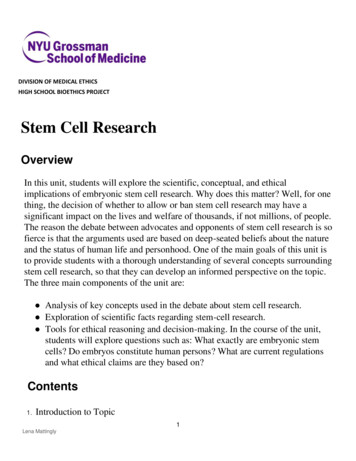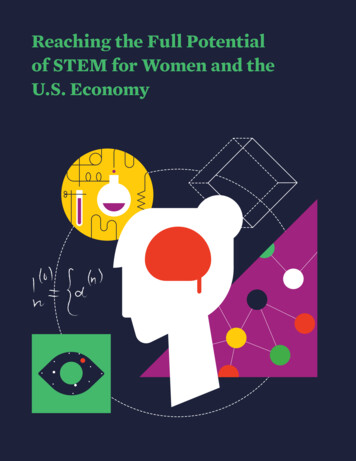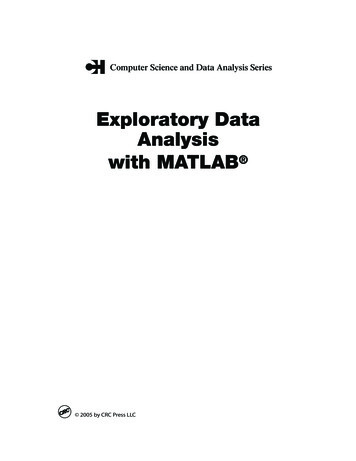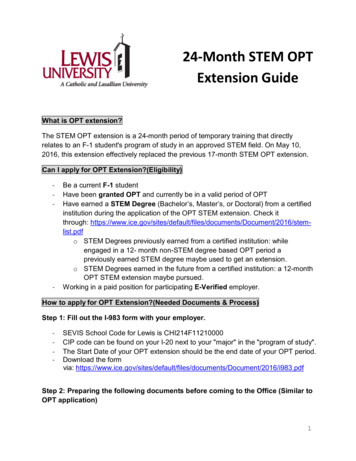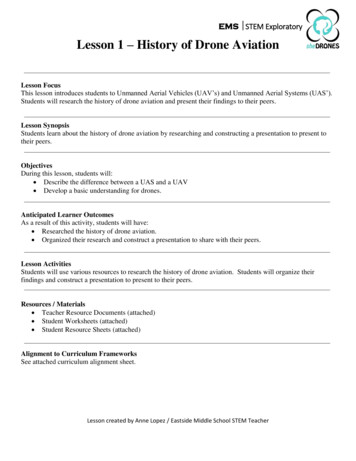
Transcription
EMS STEM ExploratoryLesson 1 – History of Drone AviationLesson FocusThis lesson introduces students to Unmanned Aerial Vehicles (UAV’s) and Unmanned Aerial Systems (UAS’).Students will research the history of drone aviation and present their findings to their peers.Lesson SynopsisStudents learn about the history of drone aviation by researching and constructing a presentation to present totheir peers.ObjectivesDuring this lesson, students will: Describe the difference between a UAS and a UAV Develop a basic understanding for drones.Anticipated Learner OutcomesAs a result of this activity, students will have: Researched the history of drone aviation. Organized their research and construct a presentation to share with their peers.Lesson ActivitiesStudents will use various resources to research the history of drone aviation. Students will organize theirfindings and construct a presentation to present to their peers.Resources / Materials Teacher Resource Documents (attached) Student Worksheets (attached) Student Resource Sheets (attached)Alignment to Curriculum FrameworksSee attached curriculum alignment sheet.Lesson created by Anne Lopez / Eastside Middle School STEM Teacher
EMS STEM ExploratoryLesson 1 – History of Drone AviationFor Teachers: Teacher ResourcesLesson Goal:The goal of this lesson is that students develop an understanding for drone aviation and how it has evolved.Lesson ObjectivesDuring this lesson, students will: Describe the difference between a UAS and a UAV Develop a basic understanding for drones.Materials: Computer with Internet access Engineering Notebook Student worksheets Student Resource SheetTime Needed: Four – Five, 45 minute sessions The lesson can be done in as little as 3 class periods for older students. However, you don’t wantstudents to feel rushed. So, to ensure student success (especially for younger students), split it into fourto five periods giving students more time to research and analyze their findings.Procedure:1. Break students into groups of 3-4. Have students brainstorm what they know about drones (priorknowledge). Brainstorming can be completed in a variety of styles: having students do a “Graffiti”brainstorm, Pictionary Brainstorm, or Round Robin style.2. Hand out the History of Drones student worksheet.3. Discuss the project with students, drawing prior knowledge from groups into the discussion.4. Provide students with a timeline of the project.5. Review the Student resources with the class and appropriate use of technology.6. Allow students to begin working on the project.7. At the end of the project, provide each student a peer rubric page. Students will present their findings tothree of their peers, who will grade their project according to the peer assessment rubric.Teacher Prep: If using postermywall.com, teachers must first create a teacher account and create a class for students towork in. Provide students will basic supplies: construction paper, glue, coloring utensils, etc. to make theirposters.Lesson created by Anne Lopez / Eastside Middle School STEM Teacher
EMS STEM ExploratoryExamples of Student Work:Lesson created by Anne Lopez / Eastside Middle School STEM Teacher
EMS STEM ExploratoryLesson 1 – History of Drone AviationFor Teachers: Teacher ResourcesAlignment to Curriculum FrameworksNext Generation Science Standards Grades 6-8 (Ages 11-14)Engineering DesignStudents who demonstrate understanding can: MS-ETS1-1 Define the criteria and constraints of a design problem with sufficient precision toensure a successful solution, taking into account relevant scientific principles and potentialimpacts on people and the natural environment that may limit possible solutions.National Science Education Standards Grades 5-8 (ages 10 - 14)CONTENT STANDARD E: Science and TechnologyAs a result of activities, all students should develop Abilities of technological design Understandings about science and technologyStandards for Technological Literacy - All AgesTechnology and Society Standard 6: Students will develop an understanding of the role of society in the development anduse of technology. Standard 7: Students will develop an understanding of the influence of technology on history.Design Standard 10: Students will develop an understanding of the role of troubleshooting, research anddevelopment, invention and innovation, and experimentation in problem solving.Lesson created by Anne Lopez / Eastside Middle School STEM Teacher
EMS STEM ExploratoryLesson 1: History of Drone AviationStudent WorksheetYou will investigate the history of Unmanned Aerial Vehicles (UAV’s) and Unmanned Aerial Systems (UAS) and findout their impact on society. You will learn how it may be used differently today than it was 10 years ago, 25 years ago,100 years ago. You will use various resources to find the information, including print, multi-media, and the web. BeAWARE that every site on the web is not always reliable, so verify your resources. Your presentation will include theminimum requirements below. Answer the questions in your notebook and then prepare a presentation to share what youfound with your classmates.DO NOT SIMPLY ANSWER THESE QUESTIONS IN ORDER ON YOUR POSTER! ANALYZE YOUR RESEARCHAND CREATE A PRESENTATIONYou will: Gather information about UAV’s and UAS’, taking notes in your engineering notebook. (These notescount towards a notebook grade. Clearly label your notes.)Create a presentation from your information to share with your classmates. This presentation can be in tofollowing formats:o Traditional Poster – two 8 ½ x 11” sheets of paper (any color) with a piece of construction paperon back of papers to make it sturdy (This also adds a border around you’re the entire poster).o Online poster – that will be printed here at school and presented in class www.postermywall.com Click on Login then click on “Student Login” Use the class code:All presentations must include the minimum of the information shown below: the bullets are to help you answer the # question***Include your name & team name (bottom right corner of poster)1. All resources used (bottom left of poster) www.google.com is NOT a resource, it is a search engine Wiki – of any type cannot be used Please ask me if you are unsure of any website! See approved websites below.2. Explanation of UAV’s & UAS’ What is a drone & how are drones used? Why does the government use drones? How are drones used for personal/recreational use? Commercial use? What are the benefits of using a drone? What are the drawbacks? (pro’s / con’s)3. List the discipline(s) of engineering most important to the development of drones What type of engineer(s) makes the drone? Fly’s a drone? Explain why these types areengineers are important to UAS’/UAVs.Lesson created by Anne Lopez / Eastside Middle School STEM Teacher
EMS STEM Exploratory4. Provide a timeline drawn to scale showing the history of drone aviation and evolution of drone aviation. Who was the original inventor and when were drones product invented? How was it used when originally invented? How is it used today?5. Identify major changes that have occurred in the design of UAV’s and UAS’. What are some of the innovations (changes) that this product has undergone since its originalinvention?6. Address the global impact on society and the environment. How has this product impacted society in a positive way? How has this product impacted society in a negative way?Internet Resources: these are not exclusive, but a good starting point**Remember, if you are unsure of a website. Please ask for assistance.**ALL resources must be included on your presentation. The Pro’s & Con’s of Drones http://www.philforhumanity.com/Drones.html http://drones.procon.org/18 awesome ways drones are being used rones-are-used-today/How Drones are being used -used-in-us/History of Drones Timeline esThe history of drones in 9 minutes (Video) http://www.popsci.com/watch-brief-history-drone10 Ways Drones will impact Society Drones: What they are and how do they work? http://dartdrones.com/commercial-use-of-drones/5 Benefits of Drones that might surprise you he Commercial use of drones litary Air Robots ary-air-robots/disadvantagesLesson created by Anne Lopez / Eastside Middle School STEM Teacher
EMS STEM ExploratoryLesson 1: History of Drones RubricElements4 Points2 Points1 PointsScience Content Concept fully andproperly explained Insight present Understanding presentand apparent. Content is accurate,comprehensive and wellsupported Excellent use ofresources Adequateexplanation Some level ofunderstandingshown. More than oneresource present Poor explanation,minimal Misinterprets thescience, needsserious refinement One resource for sure No analysis ofscience topic No explanation No science specificconnection No use ofresources Defined Sections Clear headings Flows nicely to assist thereader without help Finished product All section present,but unclear Clear headings Must re-read forclarity Some evidence ofrefinement No headings, butsectioned Hard to follow,requires assistance Missing parts Obvious refinementrequired Clutter, nodefinitive sections,all over the place Not all sectionspresent Interesting, engaging,visually stimulating Aesthetically appealinguse of color, diagramsand text Interest, motivation,effort and time obviouslypresent Some use of color,diagrams, etc. Will engage but willnot stimulate Very little use of coloror pictures butenough to engageand hold attention Bland, no variability No use of color ordiagrams Boring to look at,does not catchyour attention Interest,motivation, effortand time obviouslyabsentOrganizationCreativity3 PointsNameTotal / CommentTotal / 12 x 100 %Score for projectLesson created by Anne Lopez / Eastside Middle School STEM Teacher
EMS STEM ExploratoryLesson created by Anne Lopez / Eastside Middle School STEM Teacher
Lesson 1: History of Drone Aviation Student Worksheet You will investigate the history of Unmanned Aerial Vehicles (UAV's) and Unmanned Aerial Systems (UAS) and find out their impact on society. You will learn how it may be used differently today than it was 10 years ago, 25 years ago, 100 years ago.

